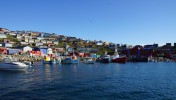Greenland 2015 - Sailing Expedition "Over Green Islands"
Leg: 15.12
Cruise rout: Upernavik - Sisimiut
This stage begins in the largest port of northern part of the Greenland. Well connected by both sea and air, is the main starting point for many expeditions to northern Greenland. Upernavik, is famous from its world’s northernmost open-air museum. A unique wildlife dominates the Upernavik area, which also has the world’s largest bird cliff, Apparsuit. Another famous mountain is the town’s landmark, Qaarsorsuaq at 1100 metres. Hunting still plays a significant employment role in the settlements. Narwhals are still caught in the traditional way by kayak in Melville Bay, where beluga whales and polar bears are also hunted. In Greenland the hunting is tradition and it is allowed only for local needs. Not any sales nor export of meat or furs is allowed outside the Greenland area. Still heading to the south after about 200 Nm of sailing we will reach Uummannaq, located on Uummannaq Island located in the south-central arm of the Uummannaq Fjord. There are many artefacts and ruins at Uummannaq that provide concrete evidence to show that hunters and trappers have lived in the area for millennia. One of Greenland’s most remarkable archaeological discoveries was made in 1972 at the old winter settlement at Qilakitsoq. A group of well-preserved mummies were found here dating from about 1475. The island is also home to Uummannaq Mountain, rising very sharply to the height of 1170m. Climbing it requires technical skills.
From there we will sail around Nuussuaq Peninsula trough Sullorsuaq Strait, a strait which separates Nuussuaq Peninsula in the northeast from Qeqertarsuaq Island in the southwest.
Along the way, will try to enter the bay whalers (Rhoden Bay- Gulf or Red) This is a beautifully situated village was the whalers settlement, with wonderful views of the glaciers and a great restaurant serving traditional cuisine H8 Greenlandic stated, however, in a very modern way.
The strait waterway connects inner Disko Bay in the southeast with Baffin Bay in the northwest. Qeqertarsuaq is also a port and town located on the south coast of Disko Island. The town was founded by whaler Svend Sandgreen in 1773. Whaling has been very important ever since for Qeqertarsuaq, also known as Godhavn in Danish. Hunting and fishing are still the main occupations of the island’s inhabitants, of whom nearly 900 live in Qeqertarsuaq and about 40 in the settlement of Kangerluk, a few hours sailing north-west. It’s around here in 1999 that researchers discovered a “galloping” glacier that moves up to 100 metres a day. The town is now home to a campus of the University of Copenhagen
The next place , just opposite in Disko Bay is the most magnificent world’s northern area, popular for sailing and a touristic place – Ilulissat (Jakobshavn). With its population of 4,546 as of 2010, it is the third-largest settlement in Greenland, after Nuuk and Sisimiut. The town was established as a trading post by Jacob Severin’s company in 1741 and named in his honour. The name was sometimes anglicised as Jakobshavn. The Zion Church (Zions Kirke) constructed in the late 18th century was the largest man-made work on Greenland in its time.
Ilulissat means iceberg in Greenlandic and the town is beautifully situated at the mouth of the almost 60 km long ice fjord, filled with enormous icebergs from the most productive glacier in the northern hemisphere, Sermeq Kujalleq. The largest icebergs run aground at the mouth of the fjord at depths of 225-250 m and they only break free during high tide or when they are so eroded that the iceberg’s point of balance changes. In 2004, Ilulissat Ice Fjord was included on UNESCO’s list of World Heritage Sites.
Sermeq Kujalleq glacier is one of the fastest (19 m per day) and most active glaciers in the world. It annually calves over 35 km3 of ice, i.e. 10% of the production of all Greenland calf ice and more than any other glacier outside Antarctica.
From there we sail to Assiat through one of the most beautiful archipelagos north, called “archipelago of thousands of islands” which is a unique system of fjords and navigationaly difficult route to Disko Bay. Aasiaat - or Egedesminde - was built in 1759 by Niels Egede, the son of the famous Christian missionary, Hans Egede. In 1763 the settlement was moved 125 km north to its present location. Today, the old Aasiaat is a regional museum, with an excellent exhibition of the Inuit history and culture, where there are also paintings of the world famous Danish artist - Per Kirkeby. It is worth to see the museum and an interesting sculpture in the center of the town.
Sailing further south, after one sailing day (80 Nm) we will reach Kangaatsiaq (which means “quite small cape”). The city is the youngest Greenland settlement, it gained the status of the city only in 1986, but the village itself is of course much older. Kangaatsiaq is a small undamaged town where there are no big hotels or travel agencies - in fact, there are only private houses, and one Internet café.
The next destination is town named Sissimiut located just outside the arctic circle. It is the most northerly located port with the ice-free entrance in winter. Sissimut is the second largest city of Greenland, after Nuuk, with a population of 5,600 inhabitants, with full service and supply. In Sissimiut to see the reconstructed Viking turf houses.
Then the trip ends, form here is only one flight to Kangerlussuaq and from there to Copenhagen, were we will spend one night dreaming …. about next trip back to Greenland.
Back to expedition

